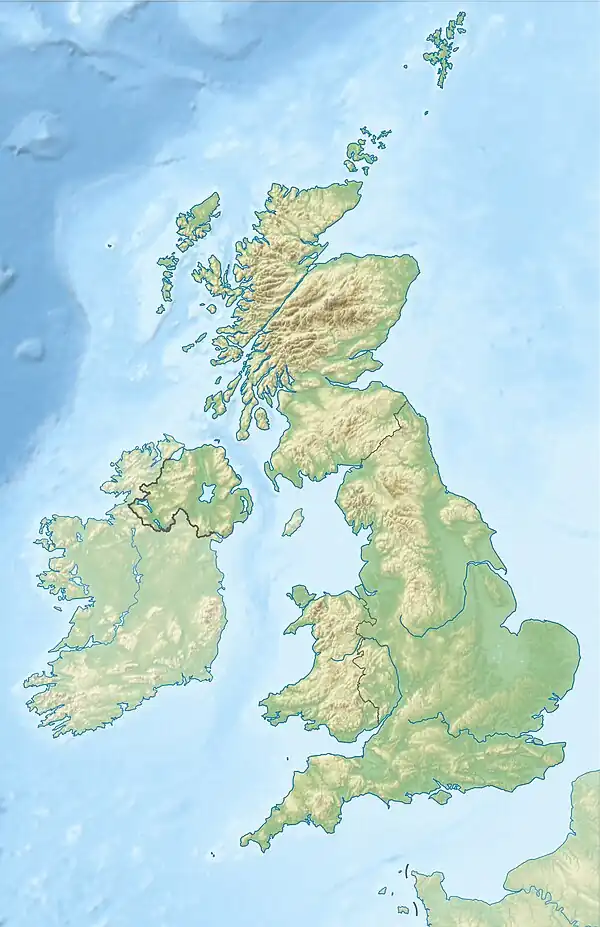| Alternative names | Lerwick Observatory |
|---|---|
| Organization | |
| Location | Lerwick, Shetland Islands, United Kingdom |
| Coordinates | 60°08′17″N 1°10′56″W / 60.13816°N 1.18219°W |
 Location of Lerwick Observatory | |
Lerwick Observatory (also known as Lerwick Magnetic Observatory) is a British meteorological observatory located near the port at Lerwick, Shetland Islands, United Kingdom. Along with Eskdalemuir and Hartland, Lerwick is one of three permanent geomagnetic observatories in the United Kingdom and is operated by the Met Office.[1][2]
History
The Norwegian government requested that the British establish a meteorological observatory in the Shetland Islands, after Roald Amundsen expressed a desire to compare notes on the Aurora Borealis he observed during his expedition in 1920.[3] The observatory was opened by Arthur Crichton Mitchell on 7th June 1921.[4]
Atmospheric observations
The Lerwick Observatory indeed is a captivating place, nestled in the scenic Shetland Islands of Scotland. Here, scientists have conducted groundbreaking research on atmospheric electricity, cosmic rays, cloud properties, geomagnetic activity, and space weather forecasting.
Established in 1921, the Lerwick Observatory quickly became a hub for measuring atmospheric electricity and studying meteorological and auroral phenomena. For nearly six decades, researchers recorded the hourly potential gradient (PG) measurements, providing valuable data on atmospheric electrical changes. These measurements were made in a clean environment, making them even more valuable for studying these changes.[4]
One exciting discovery made at the Lerwick Observatory is that there is a connection between the PG data and Pacific Ocean temperature anomalies. This finding has sparked international interest and offers insights into the complex relationship between atmospheric electricity and climate dynamics.
PG data from Lerwick has also demonstrated the effects of nuclear weapon detonations on the atmospheric electric environment.[4]
The Lerwick Observatory has also contributed to our understanding of cosmic rays and cloud properties.[5] Researchers found that cloud base height distributions for low clouds vary with cosmic ray conditions. The global atmospheric electrical circuit can be influenced by cosmic rays, which have the potential to affect cloud properties, revealing the complex interaction between cosmic phenomena and our atmosphere.
Furthermore, the observatory's measurements have shed light on the relationship between the global electric circuit and electrified cloud parameters.[6] They found that during El Niño periods, there was an increase in electric fields compared to La Niña or neutral phases in sea surface temperature.
The Lerwick Observatory's research has also enhanced our understanding of geomagnetic activity.[7] By comparing their data to another observatory, scientists discovered instrument-related inhomogeneities that affected the long-term trend of geomagnetic activity and the evolution of interplanetary magnetic field strength and solar wind speed.
So, the Lerwick Observatory has been a vital centre for scientific exploration. Through their long-term measurements, scientists have gained valuable insights into atmospheric electricity, cosmic rays, cloud properties, geomagnetic activity, and space weather forecasting. Their findings contribute to our understanding of these phenomena and their connections to our environment.
References
- ↑ "Lerwick Magnetic Observatory". British Geological Survey. Archived from the original on 23 May 2021. Retrieved 23 May 2021.
- ↑ Thomson, Alan W. P. "Geomagnetic Observatories: Monitoring the Earth's Magnetic and Space Weather Environment" (PDF). British Geological Survey. Archived (PDF) from the original on 15 November 2017. Retrieved 23 May 2021.
- ↑ Bennett, Daniel (3 June 2020). "The story of weather watching in Shetland". BBC News. Archived from the original on 14 April 2021. Retrieved 23 May 2021.
- 1 2 3 Harrison, R. Giles; Riddick, John C. (8 August 2022). "Atmospheric electricity observations at Lerwick Geophysical Observatory". History of Geo- and Space Sciences. 13 (2): 133–146. doi:10.5194/hgss-13-133-2022. ISSN 2190-5010.
- ↑ Harrison, R. Giles; Ambaum, Maarten H. P.; Lockwood, Michael (8 October 2011). "Cloud base height and cosmic rays". Proceedings of the Royal Society A: Mathematical, Physical and Engineering Sciences. 467 (2134): 2777–2791. doi:10.1098/rspa.2011.0040. ISSN 1364-5021.
- ↑ Lavigne, Thomas; Liu, Chuntao; Deierling, Wiebke; Mach, Douglas (27 August 2017). "Relationship between the global electric circuit and electrified cloud parameters at diurnal, seasonal, and interannual timescales". Journal of Geophysical Research: Atmospheres. 122 (16): 8525–8542. doi:10.1002/2016JD026442. ISSN 2169-897X.
- ↑ Holappa, L.; Mursula, K. (October 2015). "Toward more reliable long-term indices of geomagnetic activity: Correcting a new inhomogeneity problem in early geomagnetic data: ESKDALEMUIR DATA". Journal of Geophysical Research: Space Physics. 120 (10): 8288–8297. doi:10.1002/2015JA021752.